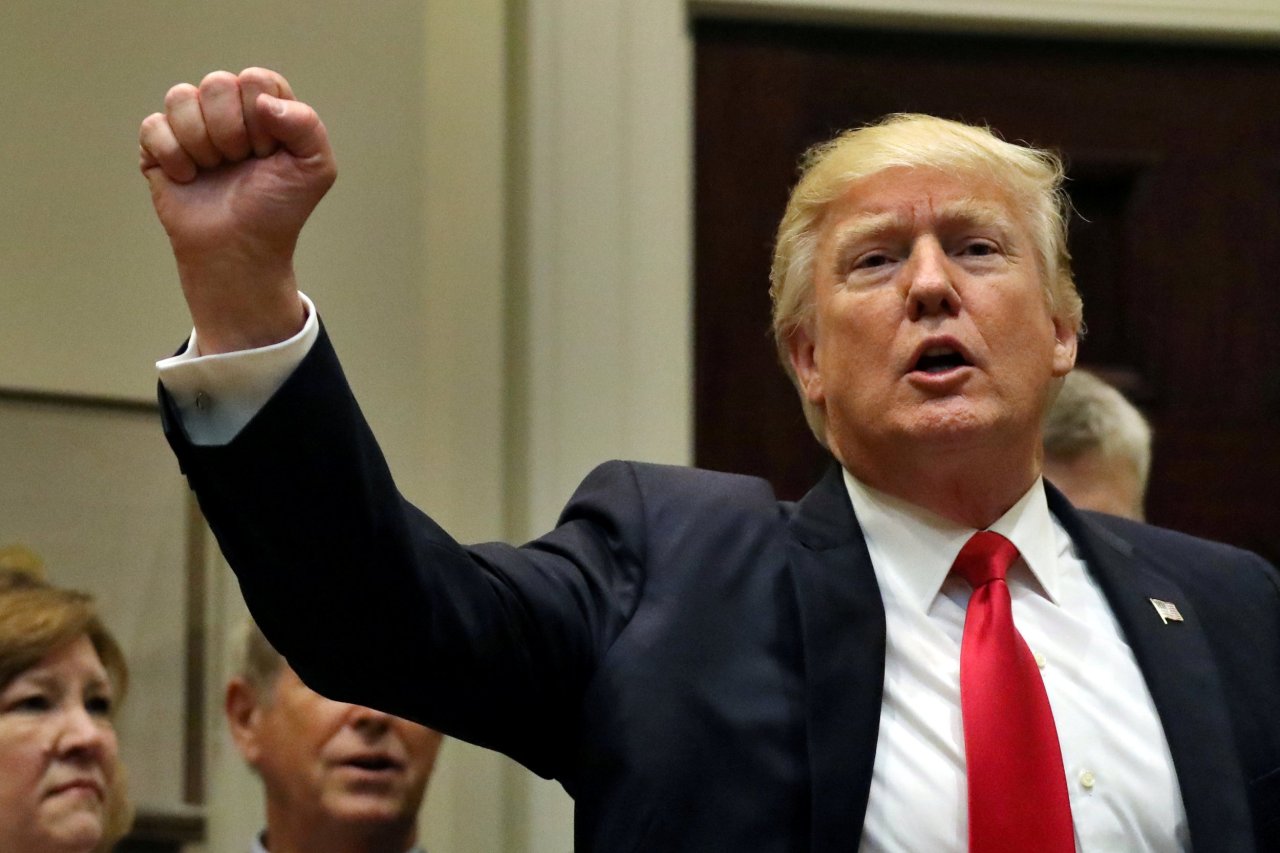
It all started in December 1974, on Dick Cheney's cocktail napkin.
Four Republicans had gathered that night at a restaurant in Washington, D.C., and the conversation turned to economics and taxes. The group—Cheney, then the deputy White House chief of staff and the future vice president; Donald Rumsfeld, then the White House chief of staff and future defense secretary; and Jude Wanniski, an editor with The Wall Street Journal—watched in interest as the last member of their party, economist Arthur Laffer, scribbled a chart on what would become the napkin that changed America.
Related: Trump's tax cuts plan: A simple guide to what you need to know
With his tissue-paper chart, Laffer espoused what the group deemed a brilliant idea. The relationship between taxes and revenues, Laffer argued, was something of a bell curve. At a zero percent income tax rate, the government would bring in no revenue. But the same held true at a 100 percent rate, since no one would have the incentive to work if all of the individual's income went to taxes. So, somewhere along the curve charting taxes to revenues, there was the perfect number—tax rate—that would bring in the most money for the government. At that one point, not only would efforts to avoid taxes through clever accounting drop but people would work more and the economy would boom, with the result that the Treasury would be showered in cash, an idea advanced by a group known as supply-siders.
Viewed in a closed economic system where only income tax rates determined revenues, Laffer's theory seemed theoretically powerful. And that was the genesis of what would become a more than four-decade mantra of Republican politicians—tax cuts increase revenue and pay for themselves. Now, with the recent proposal by the Trump administration for massive corporate and personal income tax cuts, the Laffer curve is back, as GOP politicians trot out the same old argument that decreasing rates will bring down deficits.
But despite over 40 years of making the argument, the GOP has never confronted one salient point: The Laffer curve has no numbers. Even if the theory is correct—and experience demonstrates it is not—the curve itself proves there is a point at which tax cuts become irresponsible, causing deficits to explode. Remember, it is the Laffer curve, not the Laffer declining vector. So where on that curve is the perfect tax rate to bring in the most government revenues? The empirical analyses conducted by independent economists have come up with 68 percent, 70 percent and 35 percent—all higher than the current rate of taxation, and much higher than what the Trump tax-cut plan is proposing.
Moreover, the presumptions of the Laffer curve do not exist in the real world. There is no one tax rate—there is a schedule of multiple rates, with tax cuts having a different impact on each individual's disposable income. And, because of those different rates, while major tax cuts have been enormously beneficial to the wealthy by reducing their taxes and increasing their incomes the most, the distribution of benefit for working people has been comparatively negligible. That is not the argument of some liberal politician—it was the finding of Martin Feldstein, the chief economic adviser to President Ronald Reagan, in his analysis of the Tax Reform Act of 1986.
In fact, in a 1999 analysis of six tax changes since 1922, University of Chicago economist Austan Goolsbee found that it was quite unlikely the government would raise more revenue that would offset increasing deficits by cutting marginal tax rates below where they are now. Showering even more money on the rich does not inspire the middle class to work harder; it simply increases economic inequality.
That is why, time and again, Republican economists who have served on the Council of Economic Advisers for different presidents have insisted that the "tax cuts pay for themselves" argument is a proven canard.
Greg Mankiw, chairman of the Council of Economic Advisers under George W. Bush: "History failed to confirm Laffer's conjecture that lower tax rates would raise tax revenue. When Reagan cut taxes after he was elected, the result was less tax revenue, not more."
Glenn Hubbard, who preceded Mankiw as chairman of the council under Bush: ""Although the economy grows in response to tax reductions…it is unlikely to grow so much that lost tax revenue is completely recovered by the higher level of economic activity."
And Feldstein, who worked under Reagan, said: "The height of supply-side hyperbole was the 'Laffer curve' proposition that the tax cut would actually increase tax revenue because it would unleash an enormously depressed supply of effort.… The experience since 1981 has not been kind to the claims of the supply-side extremists that an across-the-board reduction in tax rates would spur unprecedented growth, reduce inflation painlessly, increase tax revenue and stimulate a spectacular rise in personal saving. Each of those predictions has proven to be wrong."
Examining the history of tax cuts and tax increases since Reagan indisputably undercuts the arguments by these Republicans for all but the most rabid ideologues. For example, Reagan's policies are most frequently cited as proof of the wonders of tax cuts, but the story as spun by Republicans in an attempt to justify more decreases in rates is not true. In 1981, Reagan was correct that taxes needed to be cut; the American economy was facing an unprecedented beast called "stagflation"—inflation (normally associated with a runaway economy) and high unemployment (normally associated with low inflation). The Federal Reserve, under chairman Paul Volcker, needed to squelch inflation with a huge increase in interest rates, and did. One month before Reagan took office, the prime rate hit its all-time high of 21.5 percent. With the cost of money at the highest rates in history, economic activity slowed to a near crawl.
Outside of monetary policy, the other lever available to the government was fiscal; attempting to get more money in the hands of Americans was important to prevent the economy from imploding. Laffer and other supply-siders promised that, before the ink was dry on the new law cutting taxes, the economy would boom. But when the tax cuts went through in 1981, nothing happened. By the following year, the economy was in such terrible shape that Republicans were not running on Reagan tax cuts, and the president was pleading with the electorate to "stay the course."
Related: Want to pay fewer taxes? Whatever you do, don't cheat
The economy was getting notably worse. The reason: Tax cuts are not the gas pedal for the economy. There are numerous factors that play into economic growth, with interest rates historically being the most significant. Beginning in the first full quarter Reagan was in office through the 1982 election, the growth in gross domestic product was negative 8.9 percent. (By way of comparison, for the comparable period in President Barack Obama's term, GDP growth was positive 15 percent.) A few months after the 1982 elections—in February 1983—the Fed had finally cut the prime rate below 11 percent, less than half of what it was when Reagan took office. And, with the cost of money much cheaper, corporations and consumers unleashed a flurry of economic activity: By the end of the first half of 1983, GDP growth had reached positive 5.1 percent. By the 1984 elections, GDP had grown by just under 34 percent since January 1983. If interest rates hadn't dropped so precipitously, Reagan almost certainly would have been a one-term president.
Despite that history, the mythology about the Reagan tax cuts has so thoroughly dominated the debate that even senior Republicans seem unaware of this stark economic history. During a debate about whether to preserve certain tax cuts for the wealthy put in place in the George W. Bush administration, Eric Cantor, then the House majority leader, appeared on 60 Minutes for an interview with Leslie Stahl. Cantor argued that Reagan never compromised in advocating tax cuts, but Stahl pointed out that the former president raised taxes numerous times, with the biggest hike in 1982, before economic activity took off. "That just isn't true," one of Cantor's aides yelled off-camera, "and I don't want to let that stand." Cantor did nothing to correct his aide, who was wrong.
The year after Reagan signed his tax cuts, the administration decided it had gone too far. Revenue was collapsing, so, in 1982, Reagan signed the Tax Equity and Fiscal Responsibility Act. While Americans still received tax cuts when it was aggregated with the prior year's law, TEFRA constituted the largest tax increase in American history at that time. Why did he do it? Because he wasn't, contrary to some GOP revisionists, a blind ideologue. After the adoption of the 1981 tax cuts, government analyses showed that the four-year average impact on federal revenues would be negative 2.89 percent of GDP. (Remember the supply-side claim that tax cuts pay for themselves? Well, they don't.) After TEFRA, the four-year average was positive 0.98 percent, although again, a large part of that was the result of economic growth following interest rate cuts. But, even with the growth largely attributable to the lower cost of money, because the tax cuts were cumulative negative, deficits went up. The first time in American history deficits exceeded $100 billion was in 1982. The deficits stayed above that until 1998, during the Clinton administration. The first surplus came in 1999. The declines followed an increase in tax rates on the wealthiest Americans under President Bill Clinton in 1993. Republicans—who voted unanimously against the tax increase bill—predicted it would lead to a massive recession. Instead, it was followed by one of the greatest periods of economic growth in history, with higher tax rates increasing federal revenue and allowing the government to reduce the amount of publicly held outstanding debt.
In fact, given that, even under their own Laffer argument, there is a point where tax cuts reduce government revenues, Republicans who cite the Reagan experience—however incorrectly—as proof that a particular rate leads to an economic boom should be calling for higher taxes. The total average federal tax rate for all income quintiles was between 21 and 22 percent in the Reagan years. When Obama took office, it was 17 percent. If the Democrats introduced a bill calling for a return to the tax rates under Reagan, that aggregate number would increase by more than 20 percent.
The last fantasy argument from the Reagan years is that deficits went up solely because Democrats pushed for higher spending. Once again, the economic data prove that is not true. According to a 2002 report prepared by the House and Senate Appropriations committees, when all appropriations bills during the Reagan administration are taken into account, the big spender was Reagan. All told, the report shows, Reagan requested about $4.7 trillion in his budgets submitted to Congress—including the regular annual budget and the supplemental and deficiency appropriations. In the final action, Congress spent a bit less than that amount. But, in truth, none of that matters. History has repeatedly shown that when taxes go up, tax revenues increase significantly, and when tax rates go down, the revenues drop.
George W. Bush proved that the Laffer curve cannot suspend arithmetic. When he assumed the presidency, the budget was in surplus, and the projections showed that the government would be able to pay down much of its debt within the next six years. Then came the Bush tax cuts. Beginning in 2002, the federal government fell into deficit again—and it still hasn't recovered. The deficit is the annual contribution to the total debt owed by the federal government, and that number began climbing in 2002 in ways that are unprecedented in the history of the world. In 2002, the year the first Bush budget was effective, the total outstanding debt of the United States was $6.2 trillion. It had barely budged in size from the previous year. By the end of the final Bush budget, the total outstanding debt had almost doubled, to $11.9 trillion.
According to a 2008 report by Congress's Joint Economic Committee, the Bush tax cuts failed to stimulate investment that might have led to more jobs. (In fact, Bush's Treasury Department found that, even under the rosiest projections, economic growth would increase by only 0.04 percent more than it would have without tax cuts.) Bush's then-chairman of the Council of Economic Advisers, Edward Lazear, stated in testimony before the Joint Economic Committee that "I certainly would not claim that tax cuts pay for themselves."
In the first two years of Obama budgets, the debt climbed to $13.6 trillion. But why? GOPers like to blame the stimulus—contrary to all available evidence. The stimulus did add an amount—extremely small as a percentage—in the short term. But Obama continued to have to work with the Bush tax cuts and the costly wars he inherited from his predecessor. The Bush tax cuts and the wars have been the largest factors in the continued growth of the debt by far—both under Bush and under Obama. If the Bush tax cuts had been allowed to expire as planned in 2012, the Congressional Budget Office (CBO) projected that future deficits would be cut in half, even with no further decreases in spending. But Obama caved to Republican pressure and allowed the tax cuts that most benefited the wealthy to continue.
That same year, Standard & Poor's downgraded American debt for the first time in history. The reasons: Some Republicans threatened to let America default rather than raise the statutory debt ceiling, and the insistence on preserving the Bush tax cuts even in the face of massive deficits.
In the face of all this historical evidence and widespread derision by even conservative economists, how can Republican politicians push through a tax cut saying it will accomplish what has never happened in history—with a decline in rates paying for themselves—in the face of what is certain to be the same overwhelming economic analyses showing that the policies will cause the deficit to explode? Some are already advocating that the CBO and other government economists be forced to adopt what amounts to little more than cheating: calculate the impact of tax cuts by assuming a massive boom in the economy, a concept known as dynamic scoring. In other words, the analysis would prove the argument by assuming the argument is true.
Deceptive, yes, but even that will not be enough to prove tax cuts pay for themselves. First, the Republicans making these arguments do not understand how the economic analyses prepared by the CBO and the Joint Committee on Taxation are done. Expected microeconomic and macroeconomic changes are already factored in when examining the impact of tax changes; they just do not adopt scenarios that have never occurred in history as the assumed result.
But more important, those who push for these more aggressive economic assumptions for dynamic scoring fail to prove tax cuts pay for themselves. The error, once again, is assuming the economy is a simple thing that runs solely on tax cuts.
In 2003, Douglas Holtz-Eakin, an economist in the Bush White House, was named as CBO director. Republicans hoped that with a conservative in place, dynamic scoring would be adopted on a significant scale and could be used to justify more tax cuts. But Holtz-Eakin is a respected economist, not a politician. When pressed to conduct analyses using significant dynamic scoring, he and his staff put together a study on tax cuts and their estimated impact on government revenues. But these skilled specialists knew what the politicians did not—tax cuts and economic growth do not take place inside a bubble. The study also included estimates of the effects on interest rates, inflation and an array of other economic variables. The conclusion: Positive effects from the assumed economic boom following tax cuts were offset by the negative impact of higher interest rate payments that Washington would have to make to the holders of government bonds. As a result, even with significant dynamic scoring, tax cuts failed to pay for themselves.
There are only two reasons for tax cuts. First, rates are so high that they are demonstrably impeding economic growth. Second, rich people want them. Given the Republican citation of Reagan's handling of the economy as a reason for tax cuts, when rates were higher back then, the first justification is false not only through the analyses of economists but even through the arguments of the politicians. As for rich people wanting to pay less taxes, that is almost always true. If politicians agree that satisfying this desire is their primary national goal, then the tax cuts should be adopted. But no one should, in doing so, pretend the country will not be on the same old path where deficits, once again, explode.

















